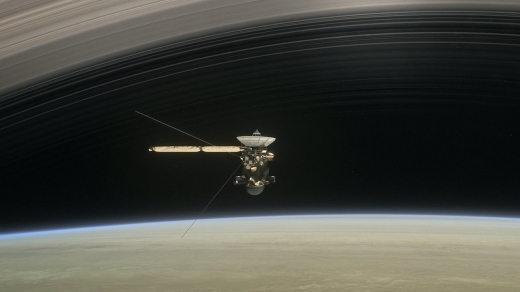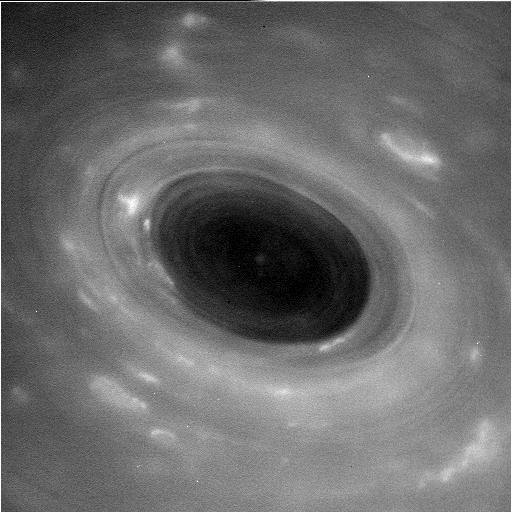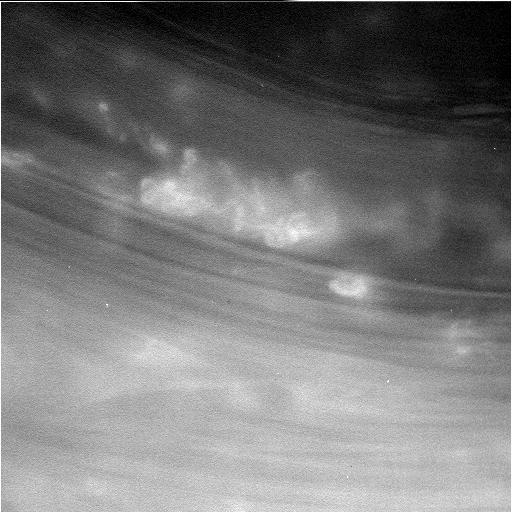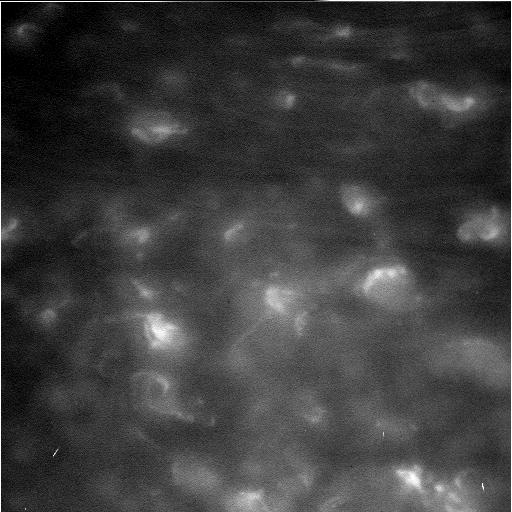Sometimes it pays to step back and try to look at spaceflight with fresh eyes. Go out and find Saturn in the sky and consider it as the ancients did, a moving celestial ember. And as you stand there, realize all over again that we’ve built a spacecraft that has been operating around that world since 2004, feeding us a datastream as its path was tweaked to look at interesting targets. The sheer magnitude of this accomplishment — Cassini is now operating between the planet and its rings! — is cause for celebration even as the mission’s end approaches.

Image: Artist’s concept of Cassini diving between Saturn and its innermost ring. Credit: NASA/JPL-Caltech/Space Science Institute.
Today’s good news is that controllers have reacquired Cassini’s signals following its plunge through the ring/planet gap on April 26, a time during which its 4-meter high-gain antenna was re-oriented to serve as an ad hoc shield against whatever dust grains or particles might be in its path. Critical maneuvers like these always produce nail-biting moments, and the spacecraft was out of contact during the entire ring-plane crossing, which occurred at 0900 UTC on the 26th, followed by renewed contact with Earth some 22 hours later.

Image: This unprocessed image and the two that follow show features in Saturn’s atmosphere from closer than ever before. These views were captured by NASA’s Cassini spacecraft during its first Grand Finale dive past the planet on April 26, 2017. Credit: NASA/JPL-Caltech/Space Science Institute.
The next dive is scheduled for May 2 in this ‘Grand Finale’ stage of the mission, during which Cassini will make a total of 22 dives, but this first one was obviously crucial in that we have a healthy spacecraft and will obviously learn more about spacecraft protection on future ring-plane crossings. As to that gap between the tenuous upper atmosphere of Saturn and the rings, it’s about 2000 kilometers. With Cassini moving through this area at roughly 34 kilometers per second relative to the planet, any small collisions could knock the craft out of commission.

But Cassini made it through. Earl Maize is Cassini project manager at JPL:
“No spacecraft has ever been this close to Saturn before. We could only rely on predictions, based on our experience with Saturn’s other rings, of what we thought this gap between the rings and Saturn would be like. I am delighted to report that Cassini shot through the gap just as we planned and has come out the other side in excellent shape.”
Science and engineering data are now being beamed back to Earth after acquisition of the Cassini signal at the Deep Space Network’s Goldstone Complex in California at 0656 UTC on April 27, with the data flow commencing minutes later. The ring-plane plunge took the spacecraft within 3000 kilometers of the cloud tops, an area where the air pressure is 1 bar, comparable to the atmospheric pressure of Earth at sea level. According to this JPL news release, Cassini also came within 300 kilometers of the innermost visible edge of the rings.

This is a good time to monitor the Cassini raw image gallery. During these ring-plane dives, Cassini will gather data about Saturn’s gravity and magnetic fields, helping us gain a better understanding of the planet’s internal structure. We’ll begin to get our closest ever imagery of the rings and atmospheric clouds even as the spacecraft’s particle detectors sample ring particles being drawn into the atmosphere. And at the end, when Cassini makes its plunge into Saturn itself, we’ll gain measurements of the atmosphere until contact is lost.
We’ve had 13 years at Saturn, and if you wonder why we can’t just keep them going, the fact is that the spacecraft is running out of the fuel needed to adjust its course. Eventually, we’d lose the ability to keep Cassini away from interesting astrobiological targets like Enceladus and Titan, with the subsequent danger of contamination. The Grand Finale maneuvers seek to draw maximum information out of Cassini’s final days before a spectacular finish.



Celestial ember. Beautiful.
Thank you, sir!
One has to wonder now if Pioneer 11 might have survived its Saturn ring plunge during the 1979 flyby mission:
http://www.honeysucklecreek.net/dss44/pioneer_missions.html
Certainly the Valley Forge survived its plunge through the rings of Saturn in 2008, and it had a cluster of big clear domes being driven by a hippie! :^)
And Carl Sagan drove the Spaceship of the Imagination right through the rings circa 1980, with no ill effects. Those particles looked like big snowballs and ice chunks, whereas the Silent Running rings seemed more like heavy snow, maybe some hail.
How many readers will know the source of that comment about the Valley Forge? Youngsters today haven’t even seen, or even know about 2001: A Space Odyssey. So the much more minor movie with that “ship” might well be unknown.
It was a test. :^)
Huey, Dewey and Louie. Of course.
Excellent. You win a free watering can and I have deactivated the literally overkill nuclear self-destruction device for one biodome.
Another thing I noticed about “Silent Running” was that–as far as I remember–no moons were depicted, not even Titan (yet Douglas Trumbull depicted several of Jupiter’s moons in “2001: A Space Odyssey”).
Good memory. I scanned the movie and you are quite correct. Saturn is depicted with no moons, just a starfield background.The rings were the classic, smooth, ones, which have now been given rich detail with our flybys and Cassini probes.
Had Trumbull been able to depict Saturn that well for 2001: A Space Odyssey, they still might have just left the moons as featureless objects as they did for the moons of Jupiter. It’s fun to speculate that if Trumbull had been able to depict Saturn, Clarke would have written 2010: Odyssey 2 with scenes around Saturn and its rings, and possibly on Iapetus where the monolith was standing.
Surface features were visible on Jupiter’s major moons during the 2001 scenes when the USS Discovery went into orbit around the planet. Granted they obviously do not resemble what we know they look like now, but Trumbull did not leave them blank slates.
You can see some of it here:
https://www.youtube.com/watch?v=6EKreQ5HD4w&t=865s
What an amazingly different mindset, that in the late 1960s they really thought we could have manned missions to either Jupiter or Saturn. Then again Clarke was part of Project Orion and one of their mottos was Saturn by 1970! And it could have happened.
And oh yes, the original design of the Discovery was as an Orion nuclear pulse spaceship…
http://www.rhysy.net/discovery-orion.html
http://astrorhysy.blogspot.cz/2014/06/learning-to-love-bomb.html
http://media.vanityfair.com/photos/53bc184ef447d4ab3b0001e5/master/h_590,c_limit/2001-space-odyssey-exclusive-ss09.jpg
You are right that there is one Jovian moon with some surface detail depicted. I hadn’t recalled it. I have captured the image here:
Jovian moon surface from 2001: A Space Odyssey
While it looks nothing like any of the actual moons, change the colors and it might just be mistaken for Io on a casual glance. Interesting, as Io was chosen as the moon most to depict in the 2010 movie.
On a semi-serious note: When I saw Silent Running, which was released in 1971, and they had the scene where Freeman flew the Valley Forge through Saturn’s rings, even then I was surprised that it didn’t cause much more damage.
Why? Because in 1970 astronomers bounced radar beams off the rings and learned the particles averaged about a meter across with some going up to the size of big boulders and small houses. So Doug Trumbull should have (or at least could have) known that the ring particles were much bigger than the heavy snow he seemed to make them into.
And why were ships carrying forests circling Saturn 800 million miles from Sol instead of much closer in? Yes I know the real reason, but still.
Ah well, they knew the lunar mountains were smooth and not jagged by the time 2001: A Space Odyssey came around in 1968, but they still made them out of something from Chesley Bonestell’s day.
The documentary on the making of Silent Running, complete film online here:
https://youtu.be/9xtsNdLj1F4
An article I wrote about SR in 2009:
http://www.thespacereview.com/article/1337/1
1 bar?
I note the comment on bouncing radar from the rings; I did not know it was done.
My related proposal is to wait the 4 years for an echo of an FRB from the Proxima system all it needs signal processing development and some radio telescopes:)
The Planetary Society at the JPL news conference on Cassini’s first pass through the ring system, mixing art with science:
http://www.planetary.org/blogs/emily-lakdawalla/2017/0428-trusty-cassini-survives-first.html
Why not put Cassini into a stable orbit and leave it be?
Where had you in mind? Not around Saturn, as that is the reason for destroying Cassini to make sure it cannot crash into a moon and survive, possibly contaminating it.